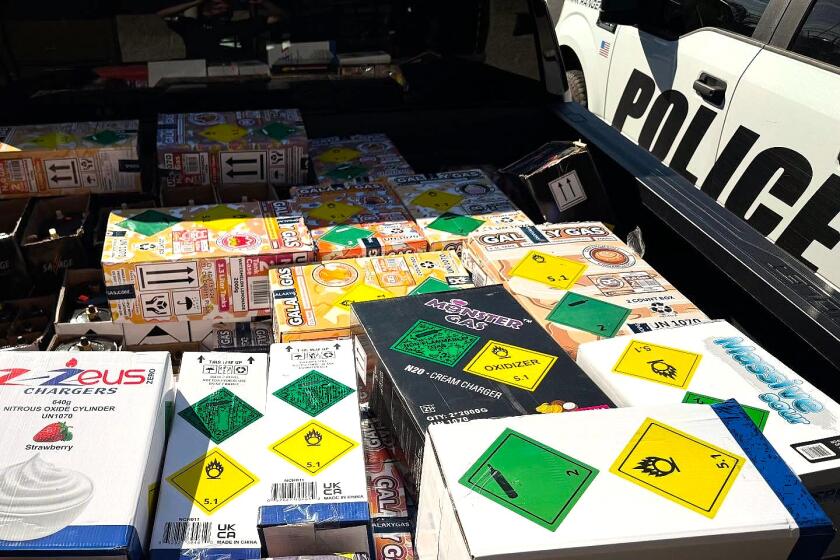In The Pipeline:
- Share via
Scene from the 1967 film “The Graduate”:
Mr. McGuire: I want to say one word to you. Just one word.
Benjamin: Yes, sir.
Mr. McGuire: Are you listening?
Benjamin: Yes, I am.
Mr. McGuire: Plastics.
My family was in the pretty little hamlet of Two Rivers, Wis., recently (birthplace, in 1881, of the ice cream sundae). After numerous local recommendations, we found ourselves eating one afternoon at Phil Rohrer’s Lunch, a tiny, old-fashioned lunch counter that’s nearly as famous as the dessert that was invented in town.
From the “raw fries” (deep fried freshly sliced potato), hamburgers in gravy, extra butter, homemade soups — welcome to Wisconsin! Our son, Charlie, after finishing a glass of iced tea (also very good), noticed something on the bottom of the amber-colored plastic tumbler: the words, “Huntington Beach.” Seems there’s no escaping this place, even in Two Rivers. Reading the finer print on the bottom of the glass, I saw that a surf city company called “Cambro” manufactured it.
Making a mental note, I went back to the gravy and butter. Once home, I thought I’d find out more about this outfit that had found its way to our little booth in Two Rivers. Not sure why, it just seemed like there might be a story there — some other little chapter in Huntington Beach history that most people might not be aware of.
Turns out, we might just be one of the plastic capitals of the world!
Two brothers, Bill and Argyle Campbell, founded Cambro here in town in 1951. This is when Bill invented the Camtray® and Argyle began selling the tray to the American Hospital Supply Corporation. According to the company history, “The Camtray was quickly embraced by restaurant, hotel, school and cafeteria operators, and it became the industry standard. Growing from this heritage, today we offer the most complete line of sizes, shapes, colors and materials in foodservice trays. Bill’s creativity was the impetus for new product development.”
Throughout the 1960s, Cambro continued to evolve, introducing the Camcover® plate covers, drinkware, dinnerware and serving bowls to provide operators with long lasting tableware and serving items. Cambro also created the first plastic food pan and the first clear food storage container. More recent innovations include the company’s exclusive FlipLid®, GripLid®, and SlidingLid™.
And it gets better! In the early 1970s, Cambro combined plastic molding with foam insulation to create the first Camtainer® (their first full line of insulated food and beverage containers that keep hot food hot or cold food cold for holding, transporting and catering).
I sat down recently with Argyle Campbell, the son of founder Bill, to hear a little more about Cambro, one of the largest, oldest family-run businesses in the city. Argyle is the president of the Cambro Manufacturing Co. today, and he has fond memories of watching Cambro grow since he was a child.
“It started on Fifth Street not too far from Main,” he said from his office on Skylab Road. “My parents didn’t like living in Los Angeles anymore,” he laughs. “I was in first grade. So my dad and his brother had this company on Fifth but it became too small so when a bigger property on Clay became available, about 11 acres, they jumped on it. That was in 1955. We also acquired a piece of property on Huntington near where the trains used to go by, from Standard Oil. And so we were really expanding.”
Shortly after finishing college, in 1972, Argyle got involved in the family business. Argyle’s dad, Bill, passed away in 1991 and shortly after that, Argyle took over the company. Right away, Argyle saw that Cambro was running out of room so they purchased a parcel on Skylab in 1993 where we are sitting now.
“It was all strawberries around here,” Argyle tells me. “This whole plot of land, and acres of acres around it, was agriculture. Then the aerospace industry arrived in this area as you know, did a lot of building, but this parcel here was available and it made sense for us.”
Reminiscing about his father and uncle, it’s clear that the Campbells were unintentional visionaries back in the brave new world of the 1950s.
“This idea of making trays for hospitals was a big deal. My dad had had a previous business failure, but then came up with this idea. He’d heard about a new material called fiberglass and thought they could make a lightweight, easily cleanable tray for patient service in hospitals. My dad was so entrepreneurial, and he helped expand the idea to cafeteria trays and beyond that. Before Cambro, people ate off wooden trays, stainless steel trays—materials that were loud and not as sanitary.”
The tray business continued to expand (thanks to Cambro’s relationship with the American Hospital Supply Corporation) and then soon, they were making plastic food containers, insulated catering products and more. Today, more than 14,000 different products comprise the Cambro catalog, and they’re the world leader in their category.
Cafeterias, military facilities, amusement parks — anywhere you eat away from home, you’re likely to find a Cambro product. Tania Nelson, director of marketing for Cambro, adds, “We also see our products in movies all the time. And while Cambro services clients all over the world today, the majority of our products are manufactured in the USA.”
“People used to ask my dad if he had a business plan,” Argyle says. “ ‘I have a hungry family to feed, that’s my plan,’ is what he’d say. He was very practical.”
Today, under Argyle Campbell’s watchful eye, Cambro employs about 750 people (and the Clay Avenue facility is still operating).
As well, many of the company’s employees live in Huntington Beach.
Next time you’re out to dinner, or having lunch in a place like Two Rivers, check the tray. Or the bottom of the glass. Odds are, you’ll be holding a little piece of your hometown, courtesy of Surf City’s own Cambro Manufacturing Co.
CHRIS EPTING is the author of 14 books, including the new “Huntington Beach Then & Now.” You can write him at [email protected] .
All the latest on Orange County from Orange County.
Get our free TimesOC newsletter.
You may occasionally receive promotional content from the Daily Pilot.



